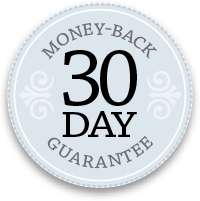What’s a Brand Promise Guarantee and how is it different from your Brand Promise? 
We continue our journey exploring Mastering the Rockefeller Habits author, Verne Harnish key strategy elements, The Seven Strata of Strategy. After careful research Verne discovered these specific strategies were key differentiators to move the needle to increase revenue faster than competitors who didn’t have these key elements identified.
Ideally your Brand Promise Guarantee is a tool that keeps your business delivering a high standard of service your customers need, and it provides an extremely high level of differentiation in the market place.
Verne Harnish references BuildDirect.com in his Fortune Magazine article: “Make it hurt to break your promise. There should be some pain in your system if you let your customers down. This keeps your team laser focused on keeping your promises. BuildDirect.com has a 30-day money back guarantee that includes paying return shipping (from $300 to $500 for a typical order), says Booth. The company offers the policy to customers who are unhappy for any reason. Nonetheless, says Booth, “Nobody uses it.” Why? The company works really hard to keep quality up and prices down.”
Your Brand Promise should have a lead promise. For Southwest, it is low fares; for McDonalds, it is speed; for Rackspace, it is finding a solution in one hour or less; Quicken is unlimited phone support. Your #1 Brand Promise should address what you feel is the greatest need your customer has that you can solve better than your competition. Your supporting Brand Promises should be additional needs your customers have that you can measure and that lend credibility and emphasis to your major Brand Promise.
Southwest and McDonald’s don’t necessarily have a Brand Promise guarantee. Rackspace as discussed in our last blog Seven Strata of Strategy - Brand Promise guarantees their customers will have their server back up and running in an hour or less or it’s free.
Do McDonald’s and Southwest need a Brand Promise guarantee? You be the judge.
In all cases you can bet that Southwest, McDonalds and Rackspace is measuring their performance.
One of my customers has been doing the same thing since developing their Brand Promise. For the past year they’ve been measuring their promise (construction industry) to get test results to their customers within ten days. That’s their promise. They’ve been 99% on target hitting this time frame. Still they haven’t decided to make this into a Brand Promise Guarantee. Do they need to? It’s a relative question. Once you make that decision you obviously don’t want to go back. They’re doing their due diligence to ensure they can meet their promise. I’d expect them sometime in the future to do so since it provides them with a measurable customer promise that will be difficult for competitors to duplicate.
A good example of the power of a Brand Promise guarantee comes from Jim Collins HBR Article, Turning Goals Into Results: The Power of Catalytic Mechanisms, July/August 1999. In the article Collins offers the story of Granite Rock, a 114-year-old company in Watsonville, California, that sells crushed gravel, concrete, sand, and asphalt.
Essentially, they take big rocks and crush them into smaller rocks and, if needed, into even smaller rocks. Almost everything that they sell is a commodity. They have an unusual BHAG for a supplier to the construction industry – they aim to provide total customer satisfaction that meets or exceeds that of Nordstrom’s, the retail giant known for exceptional customer service. The question that Granite Rock needed to wrestle with was how to measure and enforce this BHAG? They needed a key differentiator. They decided to develop a policy called “Short Pay” which works as follows: at the bottom of every invoice they send out, there is a statement which says:
‘If you are not completely satisfied for any reason with any part of this invoice, do not pay us for it. Simply scratch out the line item, write a brief note about the problem, and return a copy of this invoice along with your check for the balance.’
This policy has given them a competitive advantage that has allowed them to grow and to charge a 6% premium over the rest of the industry. Note that this is not a refund policy – customers do not need to return the product. They do not need to call and complain. They have complete discretionary power to decide whether and how much to pay based on their satisfaction level. The result inside the company is dramatic – no one wants to be part of a Short Pay policy. The policy serves as a warning system that provides hard to ignore feedback. Employees are motivated not to create a Short Pay situation, and the company monitors Short Pay situations/levels closely.
Is a Brand Promise Guarantee a key strategic element that would boost your revenue and provide you with a premium price over the rest of your industry? Perhaps you already do something inside your business that is exceptional that could provide the spark for your Brand Promise Guarantee. As Collins notes in his article, “research indicates that few companies—perhaps only 5% or 10%—currently employ catalytic mechanisms, and some of them aren’t even aware that they do.”
Next blog I’ll have some thoughts about the first Monday of the New Year. We’ll continue to explore the Seven Strata of Strategy including your One Phrase Strategy, and possibly how to support it with differentiating actions. Happy New Year!






.jpeg?width=150&height=135&name=Hand%20with%20marker%20writing%20the%20question%20Whats%20Next_%20(1).jpeg)

